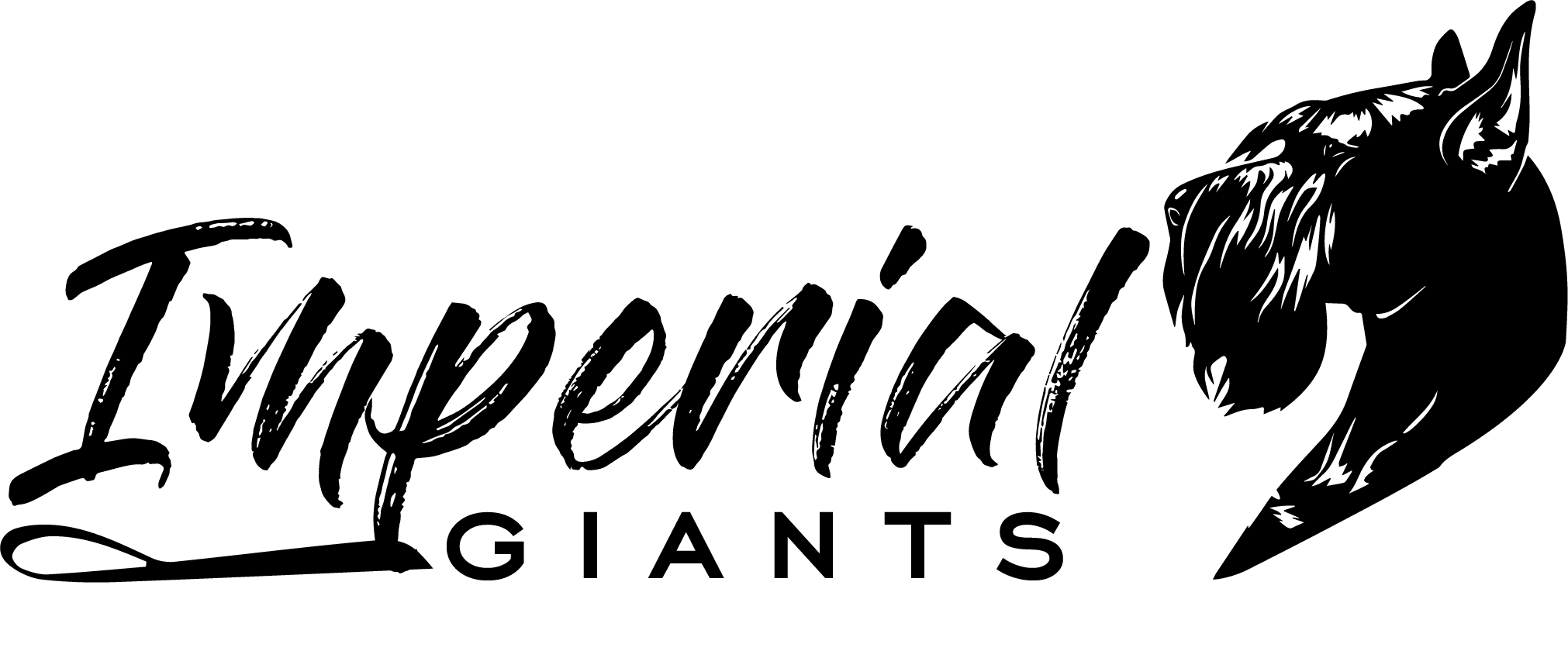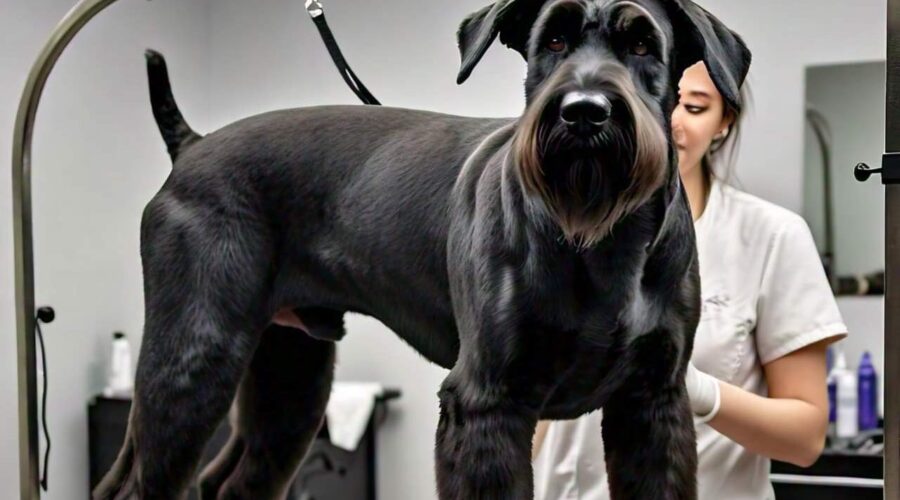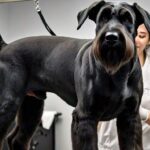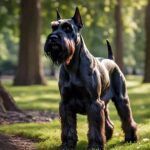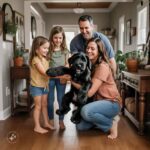Giant Schnauzer Grooming Secrets: Be The Best & Avoid Mistakes
Giant Schnauzers are renowned for their magnificent, voluminous coats, but maintaining that jaw-dropping appearance requires some insider knowledge. When I welcomed my first Giant Schnauzer into my home, I found myself a tad overwhelmed by the grooming regimen. However, as time passed, I honed a system that ensures my furry companions always look their absolute best. What’s more, I’ve turned this task into an enjoyable bonding session – our dogs eagerly anticipate the sight of their brushes, turning grooming into a delightful experience for us all.
Mastering the Fine Art of Bathing Your Majestic Giant Schnauzer
One of the first things to grasp about caring for a Giant Schnauzer’s coat is that they don’t require frequent baths like some other breeds. Over-bathing can actually strip away their natural oils, causing skin irritation, dryness, and other problems. As a general guideline, I recommend bathing your Giant Schnauzer every 4-12 weeks, or as necessary, to maintain their coat’s health and shine.
Now, onto the bathing process itself. I find it essential to turn this routine into a pleasant and calming experience for both my pup and myself. It all starts with gathering the essential supplies, including a premium-quality, gentle shampoo specifically designed for Giant Schnauzers. Their unique coat demands a specialized shampoo to preserve its luster.
Next, ensure the water temperature is just right – neither too hot nor too cold. Carefully wet your Schnauzer’s coat, being cautious not to let water enter their ears. Then, apply the shampoo, massaging it in from the neck down to their paws. Pay close attention to areas prone to accumulating dirt, such as the belly and paws.
Once you’ve thoroughly rinsed off the shampoo, finish with a gentle brushing session to eliminate any loose fur and evenly distribute the natural oils throughout their coat. This not only enhances their fur’s sheen and vitality but also aids in preventing tangles and matting. We recommend a good brushing at least twice a week to avoid serious matting.
Below is a comprehensive grooming guide sourced from GroomersU, a trusted resource for dog care tips.
Grooming Guide:
Title: How to Groom a Giant Schnauzer
Link: GroomersU – How to Groom a Giant Schnauzer
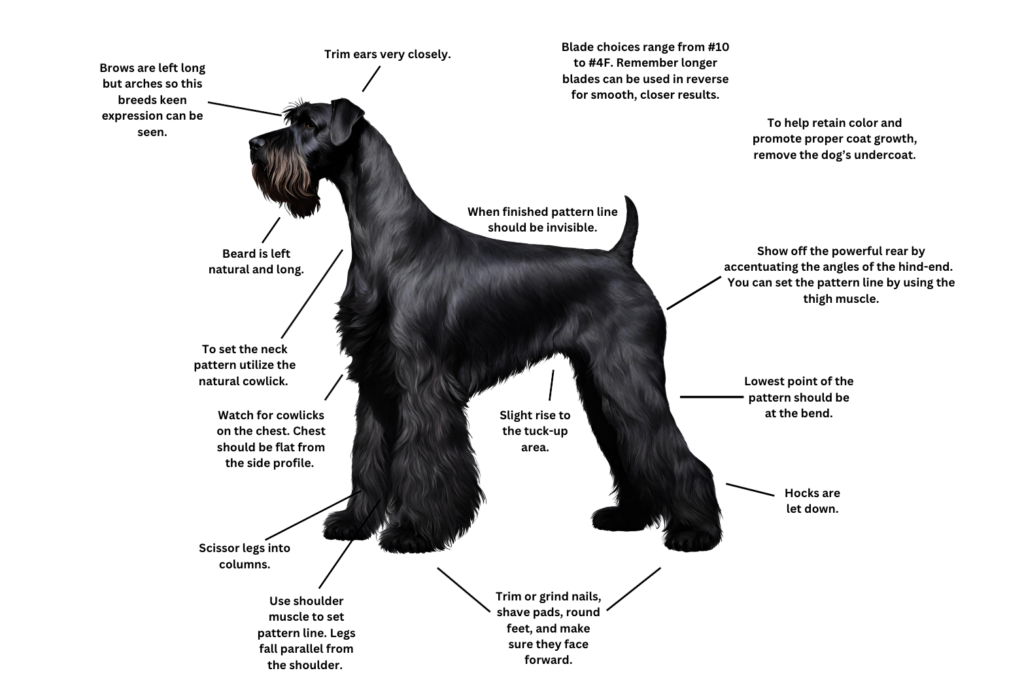
Pre-grooming Steps
Before you start the grooming process, there are some essential pre-work tasks:
- Nail Trimming: Trim or grind your dog’s nails every four to six weeks to maintain healthy foot structure.
- Ear Cleaning: Swab your dog’s ears with a mild ear-cleaning solution to prevent infections. Only pluck ear hair as necessary for ear health.
- Removing Serious Mats: Before bathing, carefully go over your dog’s body to remove any significant mats or tangles. If a tangle can be penetrated with water, leave it and remove it after the bath.
Brushing
Ensuring your Giant Schnauzer is tangle-free is crucial before any haircut. Use a firm, slicker brush or a wide-toothed comb to work through the entire body methodically. Pay close attention to areas where mats and tangles tend to hide, such as behind the ears, around the ruff, armpits, thighs, undercarriage, and tail.
Pattern Lines
The grooming pattern for a Giant Schnauzer should highlight its bone and muscle structure, with no visible lines once finished. Use the following guidelines for specific areas:
Body
The body’s pattern lines start at the turn of the shoulder, continue to just above the elbow, and then drop into the thigh region. Use typical blades ranging from #10 to #7F for pet grooming. Some stylists find that reversing a slightly longer blade is effective for achieving a smooth finish on the body. Feather off at transition points with clippers for a smooth and steady finish. If the pattern line is still visible, use thinning shears to blend it.
Undercarriage
Keep the undercarriage coat short, allowing it to get longer as you move towards the brisket. This creates the illusion of a deep chest. Viewed in profile, the distance from the elbow to the foot should be equal to the distance between the withers and the brisket. The pattern line should be well-blended and invisible.
Tail & Rear
Trim the top side of the tail with the same blade used for the body. Clip the underside of the tail and the inner side of the cowlick lines on the back of the thighs. Blend the lines so they are invisible.
Legs should be left fuller and fall into straight columns from the body to the feet, both on the front and rear legs. The hocks should be well let down, and there should be enough coat to accentuate the angles of the rear assembly.
Hindquarters
Expose the thigh muscle with the same blade used on the body. Feather off with the blade where the muscle starts to turn under on a diagonal line from the flank region to about three or four fingers above the hock.
The pattern line should be invisible when the trim is finished. The longest coat on the legs can range from 1 to 3.5 inches, depending on the amount of bone and coat density.
Front Legs
The coat on the front legs can range from ⅐ of an inch to 3 inches, depending on the dog’s size, bone structure, and coat density. Ensure the front legs drop straight down from the body and have ample bone and muscle.
The pattern line at the shoulder is about 1 or 2 fingers above the top of the elbow, where the muscle begins to turn under. Feather off at the blending point, either with the same blade used for the body or using an attachment comb, hand-scissoring, and thinning shears. The legs should form two parallel columns from the elbow to tight, round feet.
Feet
The feet are small and compact, with well-arched toes. Trim the feet very close to the edge, exposing some nail. Ensure that the feet point straight ahead without toeing in or out. Trim the feet round by creating a square shape while the dog stands naturally, then remove the sharp corners and round the feet.
Throat & Chest
Blades ranging from #10 to #7E are standard in the throat area, used with or against the grain, depending on the dog’s skin sensitivity. Follow the natural cowlick line that forms a “V” shape from the base of the ears towards the bottom of the neck.
The blending point begins about 3 or 4 fingers above the breastbone and drops to just below the turn of the muscle at the elbow/shoulder, creating a “W” shape when viewed straight on. Ensure that the neck, chest, and front legs drop straight when viewed in profile.
The Head
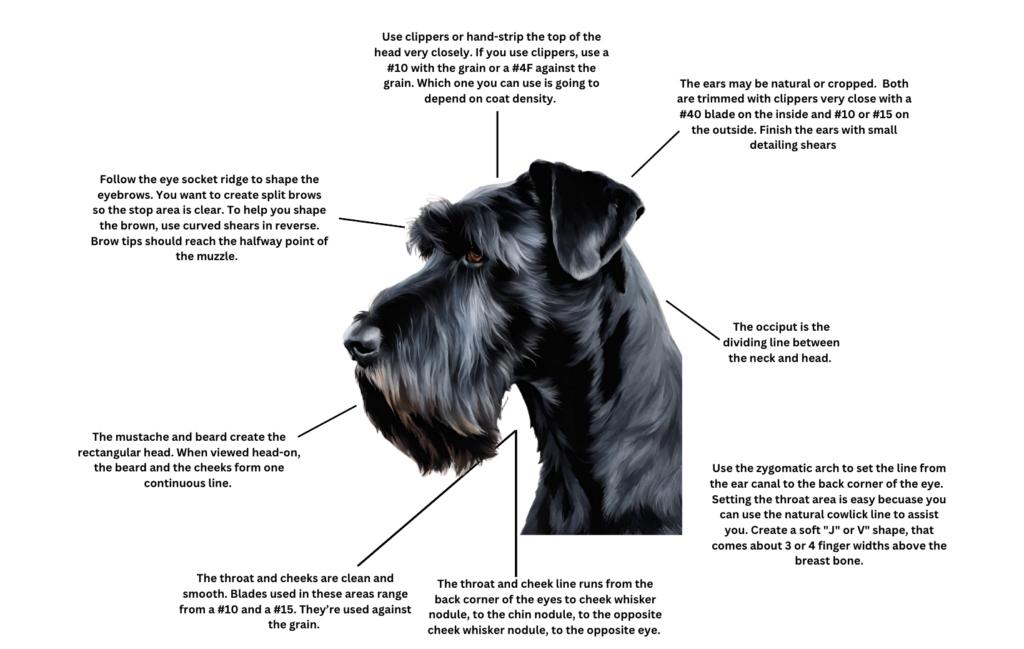
The head requires special attention when grooming a Giant Schnauzer:
Top Skull
- The top of the head can be clipped as close as a #10 used with the grain to a #7F or #5F, used with or against the grain, depending on the coat’s density and the dog’s sensitivity.
- Ears: Both cropped and uncropped ears are clipped with a close blade. Use a #10 or #15 blade on the outside of the ear leather and a #40 blade on the inside.
- Work from the base or center of the ear toward the edge, gently bracing the ear with your fingers.
- Finish by trimming around the outside edge of the ear leather with small finishing shears.
Brows
- To form the arched, triangular eyebrows, follow the eye socket rim, working with or against the grain.
- Schnauzers have a slight stop between the eyes, which acts as a natural split for the brows. You can either lightly clip this area when clipping the top skull or leave it to be done by hand with thinning shears.
- Shape the brows into long arched triangles, with them being very short at the back corner of the eye and longer at the tips, coming almost halfway down the bridge of the nose.
Throat & Cheeks
- The throat and cheek areas are clipped using blades ranging from #10 to #7F, with or against the grain.
- Use the natural cowlick line of the neck to guide the creation of the “U” or “V” shape of the throat.
- Any hair falling outside the cheekbone line needs to be removed, while hair inside the line should remain to create the correct rectangular head style.
Credit: Grooming guide sourced from GroomersU.
Disclaimer: The grooming guide provided above is sourced from GroomersU. For detailed instructions or updates, please refer to the original source at GroomersU – How to Groom a Giant Schnauzer.
Conclusion: Embrace the Majestic Presence of Your Giant Schnauzer with Confidence
When you welcome a Giant Schnauzer into your life, you’re not just getting a companion – you’re gaining a loyal, intelligent, and downright impressive furry friend. These dogs have a certain je ne sais quoi about them, don’t they? With their striking appearance, noble bearing, and unwavering devotion, it’s no wonder they’ve captured the hearts of dog enthusiasts around the world.
Now, I know it can be a bit intimidating at first, standing next to such a magnificent creature. But I encourage you to embrace that majestic presence with confidence! Your Giant Schnauzer is a reflection of your own strength, resilience, and unwavering spirit. Take pride in your pup, and let their grandeur inspire you to be the best version of yourself.
Remember, behind that imposing exterior lies a heart of pure gold. Giant Schnauzers are fiercely loyal, eager to please, and will be your steadfast companion through thick and thin. So hold your head high, my friend, and bask in the glory of your four-legged giant. The world is yours to conquer, one wag of the tail at a time.
